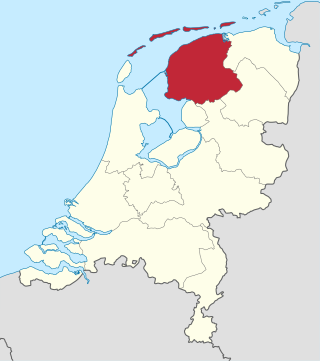
Friesland, historically and traditionally known as Frisia, named after the Frisians, is a province of the Netherlands located in the country's northern part. It is situated west of Groningen, northwest of Drenthe and Overijssel, north of Flevoland, northeast of North Holland, and south of the Wadden Sea. As of January 2020, the province had a population of 649,944 and a total area of 5,749 km2 (2,220 sq mi).

Schiermonnikoog is an island, a municipality and national park in the Northern Netherlands. Schiermonnikoog is one of the West Frisian Islands, and is part of the province of Friesland. It is situated between the islands of Ameland and Rottumerplaat.

The Tironensian Order or the Order of Tiron was a medieval monastic order named after the location of the mother abbey in the woods of Thiron-Gardais in Perche, some 35 miles west of Chartres in France). They were popularly called "Grey Monks" because of their grey robes, which their spiritual cousins, the monks of Savigny, also wore.

Termunten is a village in the Dutch province of Groningen. It is a part of the municipality of Eemsdelta, and lies about 33 km east of Groningen.

Aldersbach Abbey is a former Cistercian monastery in the community of Aldersbach in the district of Passau in the valley of the Vils, Lower Bavaria, Germany.

Schönau Abbey in Schönau in the Odenwald, in the Rhein-Neckar-Kreis in Baden-Württemberg, was a Cistercian monastery founded in 1142 from Eberbach Abbey. The present settlement of Schönau grew up round the monastery.
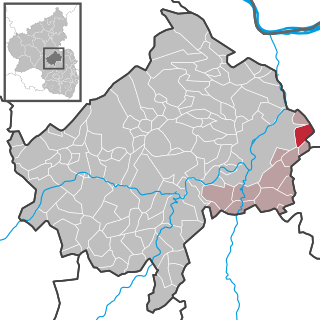
Pfaffen-Schwabenheim is an Ortsgemeinde – a municipality belonging to a Verbandsgemeinde, a kind of collective municipality – in the Bad Kreuznach district in Rhineland-Palatinate, Germany. It belongs to the Verbandsgemeinde of Bad Kreuznach, whose seat is in the like-named town, although this lies outside the Verbandsgemeinde. Pfaffen-Schwabenheim is a winegrowing village.
Roggenburg Abbey is a Premonstratensian canonry in Roggenburg near Neu-Ulm, Bavaria, in operation between 1126 and 1802, and again from its re-foundation in 1986. Since 1992 it has been a dependent priory of Windberg Abbey in Lower Bavaria. The monastery manages a training centre and a museum, and is widely known for its almost unchanged Baroque building and the organ concerts that are held in the church.

Rot an der Rot Abbey was a Premonstratensian monastery in Rot an der Rot in Upper Swabia, Baden-Württemberg, Germany. It was the first Premonstratensian monastery in the whole of Swabia. The imposing structure of the former monastery is situated on a hill between the valleys of the rivers Rot and Haslach. The monastery church, dedicated to St Verena, and the convent buildings are an important part of the Upper Swabian Baroque Route. Apart from the actual monastic buildings, a number of other structures have been preserved among which are the gates and the economy building.
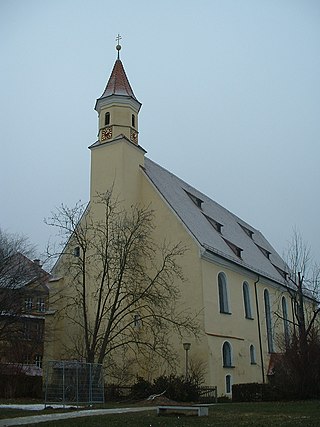
Söflingen Abbey was a nunnery of the Order of Poor Ladies, also known as the Poor Clares, the Poor Clare Sisters, the Clarisse, the Minoresses, or the Second Order of St. Francis. It was situated in the village of Söflingen, now part of Ulm in Baden-Württemberg, Germany. Being the oldest nunnery of this order in Germany, it was also its most important and most affluent.

Burdaard is a village in Noardeast-Fryslân in the province of Friesland, the Netherlands. It had a population of around 1,173 in January 2017. Before 2019, the village was part of the Ferwerderadiel municipality.

Stroobos is a village in Achtkarspelen in the province of Friesland, the Netherlands. The settlement of Stroobos used to be divided between Friesland and Groningen. In 1993, the entire village was transferred to Friesland.

Rinsumageast is a village in the Dantumadiel municipality of Friesland, the Netherlands. It had a population of around 965 in 2017.

Engelszell Abbey was the last Trappist monastery, in Austria. It is located near Engelhartszell an der Donau in the Innviertel in Upper Austria.
Daugavgrīva Abbey or Dünamünde Abbey was a Cistercian monastery in Daugavgrīva in Latvia, about 12 kilometres from Riga, of which Daugavgrīva has formed a district since 1959. The site was re-developed from 1305 as Daugavgrīva Castle.
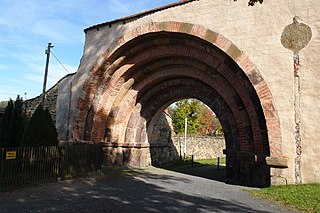
Altzella Abbey, also Altzelle Abbey, is a former Cistercian monastery near Nossen in Saxony, Germany. The former abbey contains the tombs of the Wettin margraves of Meissen from 1190 to 1381.

Aduard Abbey is a former Cistercian abbey in the village of Aduard about 8 kilometres to the north-west of Groningen in the Netherlands, founded in 1192 and dissolved in 1580.
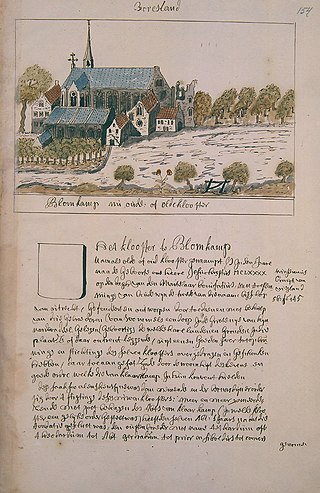
Bloemkamp Abbey is a former Cistercian abbey in the Netherlands, located in Hartwerd in the municipality of Wûnseradiel to the north-east of Bolsward, in the province of Friesland.

Hornbach Abbey is a former monastery founded around 741 in the historic town of Gamundias by Saint Pirmin, which soon became a Benedictine abbey. The most important neighbouring abbeys were Bausendorf, Saint-Avold, Glandern, Villers-Bettnach, Fraulautern, Mettlach, Tholey, and the stift of St. Arnual. The neighboring spiritual centers were Trier and Metz. At present, all that remains of Hornbach Abbey are the structural remains of the convent buildings, which have been supplemented by a monastery museum, and a modern chapel with the historical tomb of the monastery's founder.

Visvliet is a village in the Dutch province of Groningen. It is part of the municipality of Westerkwartier, and is located near the river Lauwers, the border between Friesland and Groningen.


















